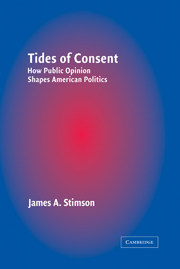Book contents
- Frontmatter
- Contents
- List of Tables and Figures
- Preface: The Shutdown
- Acknowledgments
- Tides of Consent
- 1 Opinion Flows
- 2 What the Public Wants from Government
- 3 Left and Right Movements in Preference
- 4 The Great Horse Race: Finding Meaning in Presidential Campaigns
- 5 Between the Campaigns: Public Approval and Disapproval of Government
- 6 On Politics at the Margin
- Bibliography
- Index
2 - What the Public Wants from Government
Published online by Cambridge University Press: 05 September 2012
- Frontmatter
- Contents
- List of Tables and Figures
- Preface: The Shutdown
- Acknowledgments
- Tides of Consent
- 1 Opinion Flows
- 2 What the Public Wants from Government
- 3 Left and Right Movements in Preference
- 4 The Great Horse Race: Finding Meaning in Presidential Campaigns
- 5 Between the Campaigns: Public Approval and Disapproval of Government
- 6 On Politics at the Margin
- Bibliography
- Index
Summary
The 1950s were the decade of conformity. We practiced moderation to excess. The sound of the throbbing rhythms of Buddy Holly and his Crickets was just beginning to compete with crooners and Doris Day musicals for American musical tastes. Americans warmed to the grandfatherly Eisenhower and aspired to have kids who were “well rounded.”
In politics we feared the new A-bomb. With the Great Depression cured by Roosevelt and by World War II, there was little passion for changing the domestic order, little passion for anything. It was a time of bland.
Public opinion polling, in its childhood but now beyond infancy, was more gimmick and entertainment than science. Surveys covered everything, exploring how Americans felt about everything, politics not being a particularly important part. The Gallup poll regularly explored topics such as, “Who is your favorite girl singer?”
The Michigan election surveys in 1956, seeking responses to the statement, “If Negroes are not getting fair treatment in jobs and housing, the government should see to it that they do,” found 61 percent in favor and 19 percent opposed. Two years later the balance was 63 to 18. No one noticed the change. In 1958 the Opinion Research Corporation, asking whether people approved a law that guaranteed the right to form labor unions, found the public divided 74 to II. Then two years later it was 75 to 9. At about the same time, the Michigan studies found support for government doing something to provide low-cost health care moving from about two-thirds to three-fourths in these same years of the Eisenhower administration.
- Type
- Chapter
- Information
- Tides of ConsentHow Public Opinion Shapes American Politics, pp. 23 - 57Publisher: Cambridge University PressPrint publication year: 2004

